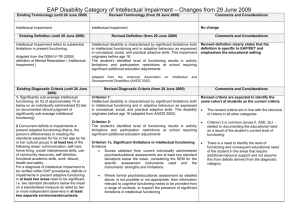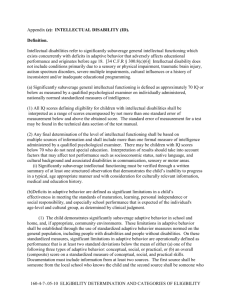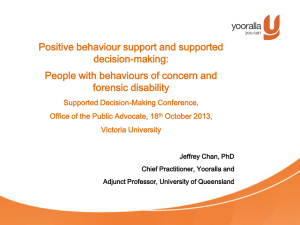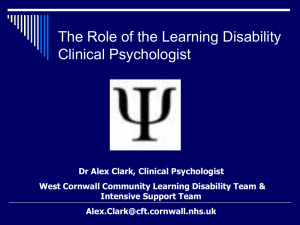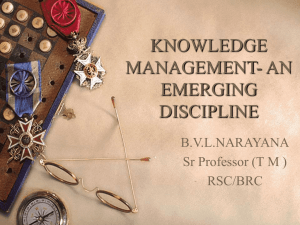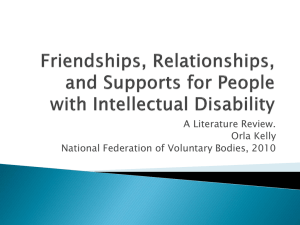Intellectual Disabilities
advertisement
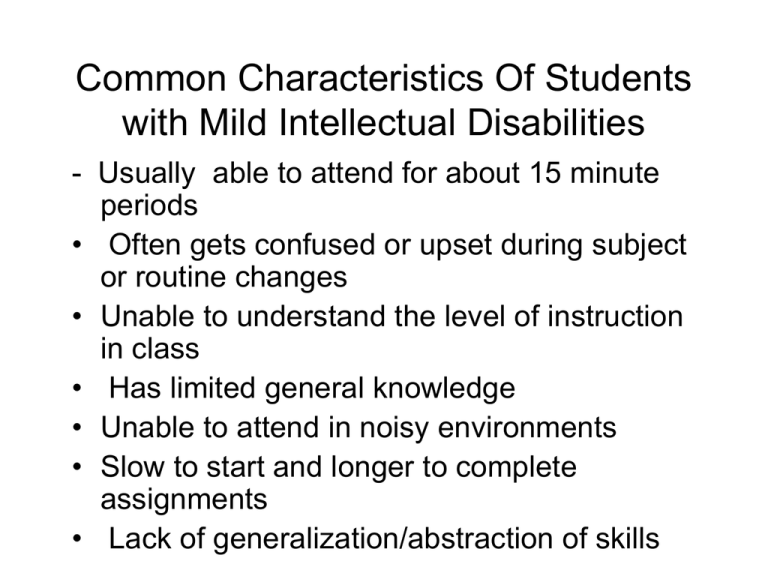
Common Characteristics Of Students with Mild Intellectual Disabilities - Usually able to attend for about 15 minute periods • Often gets confused or upset during subject or routine changes • Unable to understand the level of instruction in class • Has limited general knowledge • Unable to attend in noisy environments • Slow to start and longer to complete assignments • Lack of generalization/abstraction of skills • Easily influenced by peers and a target to be taken advantage of • Inattentive and off-task • Poor auditory processing • Socially may appear immature and more comfortable with younger students • May intrude into other students’ personal space • May bring things to share that are not socially appropriate for the age level of the group (ie: toys or immature music or books) • Intellectual Disabilities: Definition BC MEd • Students with intellectual disabilities have general intellectual functioning significantly below the mean. as well as significant limitations in adaptive functioning in at least two of the following skill areas as appropriate to the student’s age: communication, self-care, home living social/interpersonal skills, use of community resources, self-direction, functional academic skills, work, leisure, health and safety. • Students can experience intellectual disabilities across a range. • US: Revision for Mental Retardation: Mild, Moderate, Severe, Profound -BC: mild , moderate, severe, profound • A diagnosis of intellectual disability should only be made when a student has; • significant limitations in both intellectual functioning and adaptive functioning. To be referred to the Ministry as having an intellectual disability • 1) The student meets the following eligibility criteria: • a) A student with a mild intellectual disability has intellectual functioning • that is 2 or more standard deviations below the mean on an individually administered Level C assessment instrument of intellectual functioning, and • has limitations of similar degree in adaptive functioning in at least two skill areas appropriate to the student’s age. • Association on Intellectual and Developmental Disabilities (formerly the American Association * Add following slide notes to on Mental bottom of slide 8 handout Retardation) defines Adaptive Behaviours as three types of skills: • Conceptual skills -language and literacy; money, time, and number concepts; and self-direction • Social skills-interpersonal skills, social responsibility, self-esteem, gullibility, naivet� (i.e., wariness), social problem solving, and the ability to follow rules, obey laws, and avoid being victimized • Practical skills -activities of daily living (personal care), occupational skills, healthcare, travel/transportation, schedules/routines, safety, use of money, use of the telephone A student with a moderate to profound intellectual disability has • intellectual functioning that is 3 or more standard deviations below the mean on an individually administered Level C assessment instrument of intellectual functioning, and • has limitations of similar degree in adaptive functioning in at least two skill areas appropriate to the student’s age. 2) A current IEP is in place that includes: • a) individualized goals with measurable objectives, • b) adaptations and/or modifications where appropriate, • c) the strategies to meet these goals, and • d) measures for tracking student achievement in relation to the goals 3) Ongoing special education service(s) must be provided. • The services being provided are beyond those offered to the general student • population and are proportionate to level of need. • The special education services are outlined in the IEP and directly relate to the student’s identified special needs. • Reduction in class size is not by itself a sufficient service to meet the definition. Identification and Assessment • Many already identified before entering school system. For students with a mild intellectual disability, however, difficulties with adaptive behaviour may not have been previously documented. A psycho-educational assessment will be used to determine a student's level of functioning: • and should be based on a variety of measures of intellectual ability and • adaptive behaviour, • as well as information from the family and, where available, • other service providers. Common Assessment Instruments: • Adaptive Behaviour Assessment: Vineland Adaptive Behavior Scales, The Scales of Independent Behaviour, or the Adaptive Behaviour Assessment System • Intellectual Ability assessments: Stanford-Binet and the Wechsler Intelligence scales. Mild intellectual Disability • overall cognitive score as high as 75 when there are significant deficits in adaptive functioning • Similarly, a student with a cognitive score below 70 but no significant impairments in two or more adaptive skill areas (appropriate to the student’s age) would not be identified in this category. Moderate Intellectual Disability • A student may be identified with a moderate intellectual disability with an overall cognitve score as high as 70 when there are significant impairments in adaptive functioning, but would not be identified with a moderate intellectual disability if scores in two or more adaptive skill areas ( appropriate to the student’s age) are not at a similar level. Youth Transitioning to adult services • to be accepted by Community Living British Columbia (CLBC), school psychologists • must provide confirmation of a developmental disability reflecting the diagnostic • criteria of the Diagnostic and Statistical Manual of Mental Disorders, Fourth Edition: Planning and Implementation for Students with MID • Enabling students reach their personal goals and their highest level of functioning. • Parents must be given the opportunity to participate in the planning process, and to the • extent that they are able, students should also participate. • Lifeskills, adaptive skills, personal interaction skills,as well as memory, problem solving and conceptualizing within the school and in the community. For many students, continued participation For Some students: • in academic areas, with adaptations/modifications and support where needed, is both reasonable and desirable. • For other students, increasing community integration and work experience/work placement opportunities are most enabling End Powerpoint Behavioural Needs or Mental Illness • R Designation from BC Min of Ed Definitions • Students can experience behaviour, social/emotional, or mental health problems that range from mild to serious. Most students with social/emotional difficulties can be supported in school through regular discipline, counselling, and school-based services. A smaller number of students require more intensive support. Students who require Moderate Behaviour Support demonstrate one or more of: • behaviours such as aggression (of a physical, emotional or sexual nature) • and/or hyperactivity; • behaviours related to social problems such as delinquency, substance abuse, • child abuse or neglect. Students with Mental Illness are students who have been • diagnosed by a qualified mental health clinician as having a mental health disorder. To be identified in the category Moderate Behaviour Support or Mental Illness, • Students with mental • illness demonstrate one or more of the following: • negative or undesirable internalized psychological states such as anxiety, • stress-related disorders, and depression; • behaviours related to disabling conditions, such as thought disorders or • neurological or physiological conditions. Students must also meet the following criteria: • the frequency or severity of the behaviours or negative internalized states have a very disruptive effect on the classroom learning environment, social relations or personal adjustment; and • they demonstrate the above behaviour(s) or conditions over an extended period of time, in more than one setting and with more than one person (teachers, peers); and • they have not responded to support provided through normal school discipline and classroom management strategies. When teachers first notice a problem: • they will consult with the parents and attempt alternate strategies to support the student in the classroom. • teacher may seek assistance from other school-based services or from the schoolbased team. • SBT may access other school or district support services, and/or request additional assessment. It may also be appropriate at this stage to involve the family's physician, child and youth mental health services, or other community agencies in the identification and intervention process. Assessment should: • analyze the student's functional behaviours in various settings and with different people who regularly are a part of her/his environment (functional behaviour assessment); • focus on strengths as well as needs; • rule out or address other conditions which may be precipitating or contributing to the behaviour (e.g., hearing loss, learning disabilities, side- effects of medication); • clarify the characteristics of the behaviour disorder or mental illness; IEP Must Include: • current behavioural and learning strengths and needs; • the goals for the student's program referenced to measurable objectives; • the behavioural strategies used to achieve the goals and measures for • tracking student achievement of the goals; • if applicable, specification of the components of the curriculum that will be adapted and/or modified; • the resources needed to support the student; • the names of staff responsible (school, community agencies) for implementing the plan; • the role of the parents in supporting the plan; Skill set for teachers: • an understanding of behaviour disorders; • behavioural observation, analysis, strategies and management; (I.e. ABC) • consultative and collaborative skills; • direction/supervision of behavioural intervention programs; • adaptation of curriculum to meet a wide range of student learning needs will help minimize problem behaviours ** proactive • counselling skills. Functional Behavioural Assessment (FBA) • -systematic approach to trying to determine the function of problematic behaviours with the goal of determining an alternate pathway consisting of appropriate behaviours; • Form the basis of Individual Behavioral Plan
